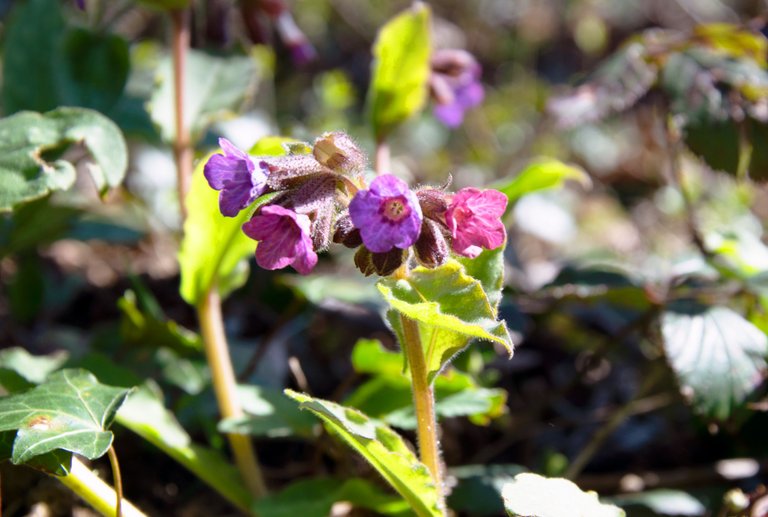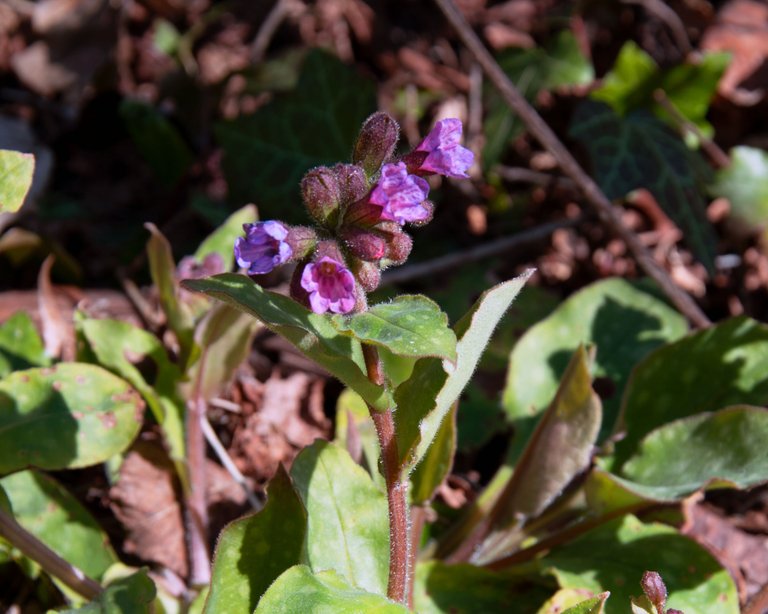Botanical description of the plant
Common Lungwort (Pulmonaria officinalis) is a plant from the family of Boraginaceae, native to Europe and Asia.
The ground leaves usually overwinter. Leaves with a heart-shaped or rounded bottom are extremely quickly tapered into a stalk and mostly sprinkled with whitish spots.
Its five-digit flowers are pink and blue at first and later pale purple.
It grows on rich and moist soils, loves shade, so it usually found at the edge of forests.

Use in folk medicine
The flowers of lungwort are harvested in the spring. In the case of a warmer winter, the first flowers can be seen in early February. It gained its reputation in folk medicine as it was sometimes used to treat tuberculosis and pneumonia. Shepherds feed dried plants to livestock, in the water if they were suffering from a cough.
Taking lungwort preparations will greatly benefit your health. Young leaves can also be prepared as spinach, or added as an addition to various salads. It is a plant that is not only good for your respiratory tract and lungs, but also has a beneficial effect on other functions in your body, such as reducing the risk of cancer and heart disease. It is also a powerful antioxidant, so it prevents premature aging and makes your skin look better.
It is also known for its diuretic effect, which can stimulate the drainage of water from the body, so it can help you with urinary tract infection.
It will also have a beneficial effect if you suffer from digestive disorders, such as bloating, water retention, diarrhea or problems with digestion of certain foods.
It is also used to cure hemorrhoids.

Lungwort tea
The plant should be dried in the shade, in a warm place. It is important that it stays green, otherwise it loses its healing effects. Pour 2 teaspoons of dried pneumonia plant with 2dcl of boiling water and let stand for 5 to 10 minutes, then strain. You can enjoy freshly brewed tea several times a day. For colds, you can drink up to three cups of tea a day, but no longer than eight days in a row.
Tea will help dilute the mucus and relax the respiratory tract, making it easier to breathe. It can be mixed with other herbs that relieve colds, especially in winter. Due to the content of tannin, saponin, silicic acid, vitamin A and C and natural antioxidant flavonoids, pneumonia is extremely effective in relieving lung and respiratory problems.
Due to the content of pyrrolizidine alkaloids, caution is recommended when using pneumonia and it is not recommended to take preparations from this plant for too long. The recommended limit of use is up to eight consecutive days.
Lungwort powder
Dried plants are crushed into powder. When the plant is completely dry, it is very small in quantity. It is used in powder form as a sprinkle to heal wounds. You can also mix it with coconut butter to get an ointment.
i thought it looked like a Borage family plant! Thanks for sharing.
I think I've only ever seen this flower in dried form, and sure I couldn't identify it in the wild. Well, now I think I can, but that will have to wait for a visit to North America, cause I don't think it grows here in the Amazon.
Thanks for sharing.
@NaturalMedicine supports wellness of body, mind, soul and earth on HIVE.
Come say hi via Lotus Chat or drop by our Hive Community - we'd love to have you!
The flowers are medicine for protect patient other.
Have you ever used it yourself? I have never found it in the wild, and it's never been on my radar, so interested to hear personal stories of it's used.
I'm very lucky to find it all around my house as I literally live in the woods. This spring is also very rich with many flowers here, since I live here I never saw so many of them bursting out.
I like to make tea out of it, but as I mentioned in the post only for 8 days in a row. I have a mild asthma and this plant is very well known to me for a long time.
As the flowers are colorful and beautiful, I like to decorate food with them, but the only food that is served and eaten right away (Panna Cotta for example), as the flowers don't stay fresh for long.
I use it in salads sometimes too, but only in small amounts, mixed with other herbs and flowers. I included them in one of my previous posts.
Nice post on lungwort. I used to have a nice mat of it in my old East garden. I had to transplant it 2 years ago due to construction. I made a new garden yesterday, another East garden, and hope to transplant it back into that next week.
I love how the blooms are pink and blue. :))
Really smart transplanting them to the garden :)
Well, it was the old frugality kicking in. Used to be I couldn't afford to buy plants, so saving them somehow was important...
Thank you for sharing.Thank you @blackberryskunk , always interested in herbs and natural medicines, I have never heard of this particular flower before, very interesting, love your post.
Thanks @artywink!
You are welcome @blackberryskunk .
Quick edit: find and replace, pneumonia with lungwort.
Thanks ;)
Sure. How have you been? Busy with the garden?
Very busy and enjoying! How have you been, my friend? 🙂
Good to be busy, if you enjoy it. I'm good, between jobs this week, so more time for the blog. :)
Congratulations @blackberryskunk! You received a personal badge!
Wait until the end of Power Up Day to find out the size of your Power-Bee.
May the Hive Power be with you!
You can view your badges on your board and compare yourself to others in the Ranking
Check out the last post from @hivebuzz:
Congratulations @blackberryskunk! You received a personal badge!
Participate in the next Power Up Day and try to power-up more HIVE to get a bigger Power-Bee.
May the Hive Power be with you!
You can view your badges on your board and compare yourself to others in the Ranking
Check out the last post from @hivebuzz: